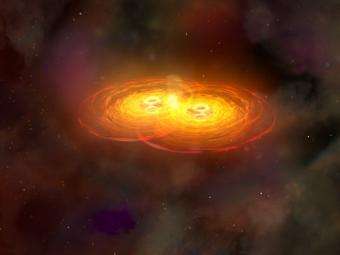Growing Supermassive Black Holes from Seeds

Astronomers announced today that they have found the first sample of intermediate-mass black holes in active galaxies - a discovery that will help in understanding the early universe. "These are local analogues of the `seed' black holes from which supermassive black holes formed," said Ms. Jenny E. Greene of the Harvard-Smithsonian Center for Astrophysics.
Greene presented these results with Dr. Luis C. Ho of Carnegie Observatories at the 207th meeting of the American Astronomical Society in Washington, D.C.
"Supermassive black holes (with masses of millions to billions of times the mass of the Sun) are found in the centers of most, if not all, massive galaxies, and the black hole masses scale with the galaxy masses, so that larger black holes reside in larger galaxies," said Greene. "We want to understand how this connection is established, and more specifically, what role black holes play in the evolution of galaxies."
Black holes probably evolve as material, such as gas, dust, stars and even other black holes, gets sucked in by the strong gravitational pull. "However, we cannot observe the starting conditions of the black holes directly," said Ho. "How massive were they? How and when were they made? These are crucial questions to answer if we want to understand how black holes impact the growth of galaxies."
The black hole "seeds" originally may have formed from the explosions of the first stars or from the collapse of clumps of gas in the early universe. Each of these different formation scenarios leads to very different numbers of intermediate-mass black holes left over in the universe today. Until now, few good candidates had been found.
Greene sifted for intermediate-mass black holes in the first data release from the Sloan Digital Sky Survey, a multi-year comprehensive survey of one quarter of the sky. (The first public data release from the SDSS contains information on 50 million objects, including spectra and redshifts for almost 200,000 objects.)
In her thesis work, Greene identified objects with black holes by detecting the light from gas moving at extremely high velocities close to the black hole. Using the speed of the gas, and an estimate of the distance of the gas from the black hole, it was possible to estimate a black hole mass for each galaxy. She then selected all of the objects with masses less than one million solar masses, yielding a total of 19 new black holes.
"This sample provides the only currently available observational constraints on the properties of seed black holes in the early universe," said Greene.
Besides the formation of supermassive black holes seen today, this data set may help with another question - the re-ionization of the universe.
Present theory holds that soon after the Big Bang, the universe was filled mostly with hydrogen and helium that was ionized - too hot to remain in a stable state. Over about 300,000 years, the universe expanded and cooled, and the gases began to recombine and stabilize to neutral states. This neutral gas acted as an opaque fog blocking the transmission of light. The universe then entered the dark ages, estimated to have lasted about half a billion years.
At the same time, matter was clumping together to form the first stars, galaxies and quasars. (Quasars are incredibly bright objects powered by supermassive black holes.) The radiation from these new objects made the opaque gas of the universe become transparent by splitting atoms of hydrogen into free electrons and protons, thus re-ionizing the universe.
"These seed black holes presumably occasionally lit up as 'mini-quasars.' It is still an open question whether the emission from small black holes played an important role in re-ionizing the universe, ending the cosmic dark ages," said Greene. "Our measurements of the light radiated by low-mass black holes will help us decide whether or not black holes in this mass range could have contributed significantly to re-ionization."
Gravity waves also could point to an early population of intermediate-sized black holes. When two black holes merge, their coalescence sends out gravity waves, or ripples in space-time.
"Gravitational wave experiments, especially the Laser Interferometric Space Antenna (LISA) expect to be very sensitive to the merging of 100,000-solar-mass black holes," said Greene. "The objects we identified will give clues to help the LISA team determine how many black hole collisions they may expect to find."
Source: Harvard-Smithsonian Center for Astrophysics
















